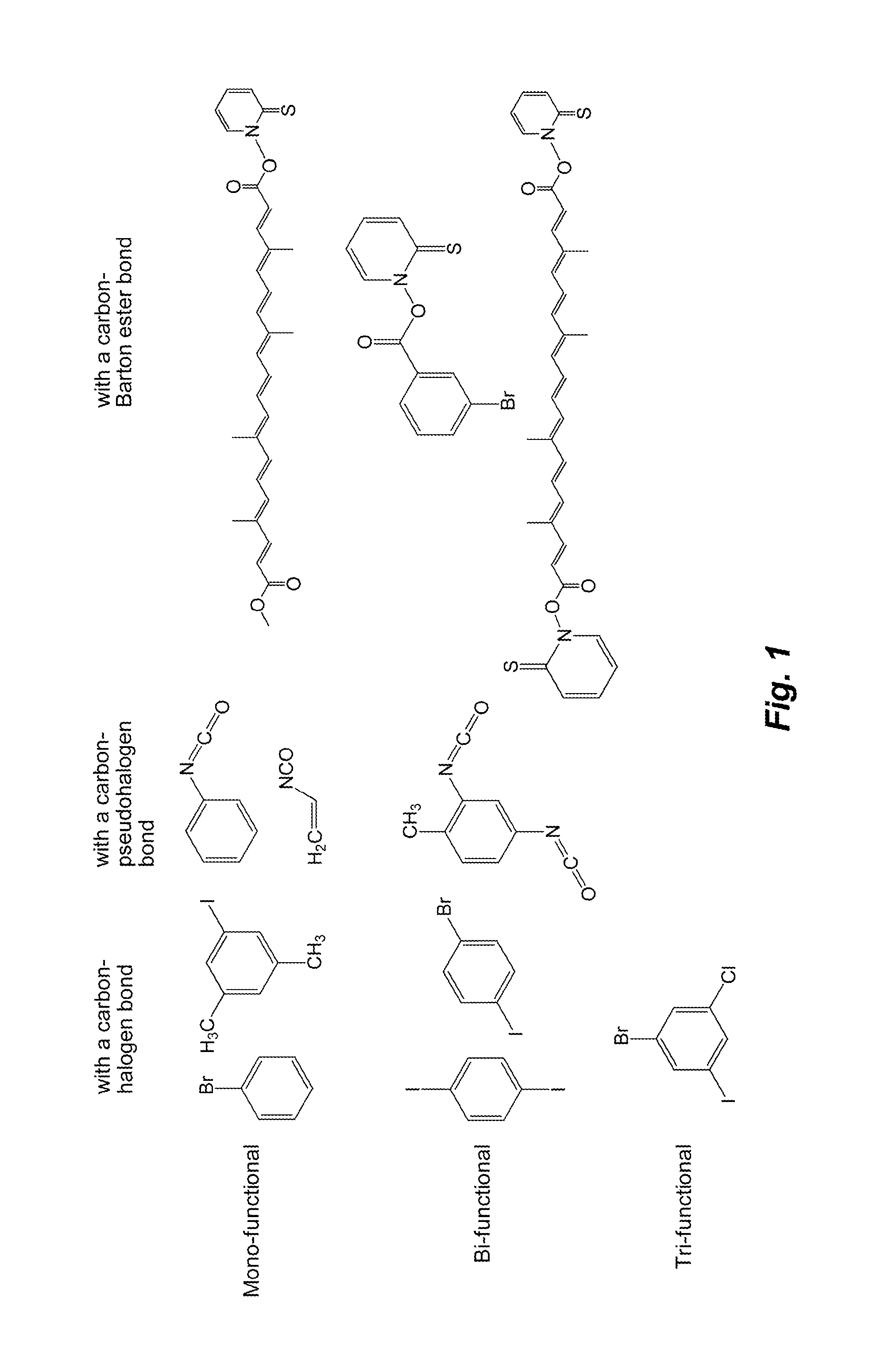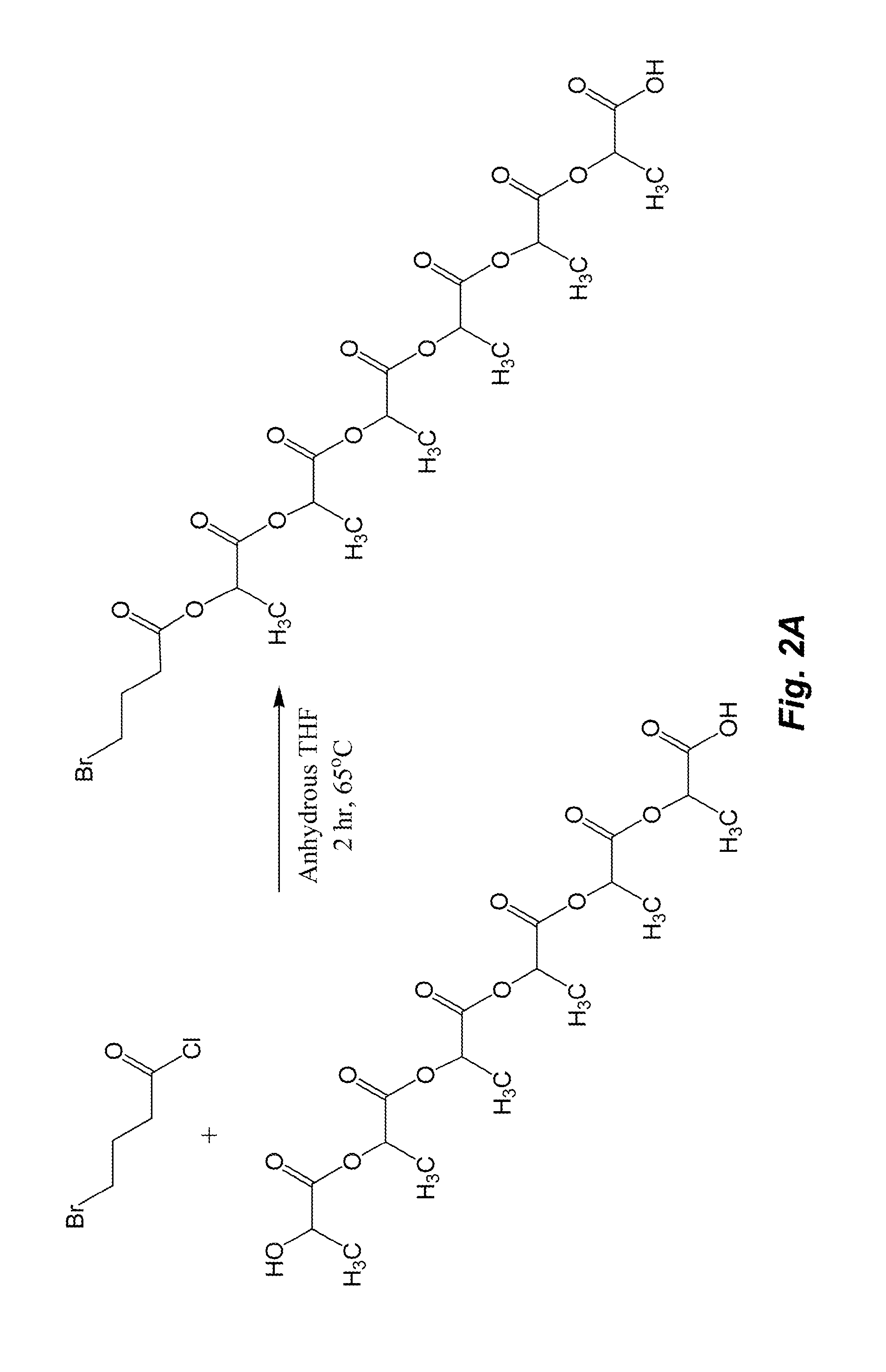NANO or macro material functionalization and self assembled construction mediated by tris(trimethylsilyl)silane
a technology of trimethylsilylsilane and nano or macro materials, applied in the field of nanocomposite materials, can solve the problems of introducing defects onto the otherwise stable, requiring harsh sonication treatment, and limited molecule use of diazonium for functionalizing materials,
- Summary
- Abstract
- Description
- Claims
- Application Information
AI Technical Summary
Benefits of technology
Problems solved by technology
Method used
Image
Examples
example 1
Facile Functionalization of CNTs for the Purposes of CNT Separation by Metallic Character and Attachment of Metallic Nanoparticles to CNTs
[0179]To functionalize metallic CNTs with 1-bromo-3-chlorophenyl: add 20 g of MWCNTs to a 2 L reaction vessel with 750 ml of dioxane under stirring to provide the substrate suspended in dioxane. Next, add 3.17 g (0.010 moles) of 1-bromo-3-chloro-5-iodobenzene to the reaction mixture under stirring. Purge the reaction vessel of oxygen and carbon dioxide while stirring for 30 minutes. Add 2.98 (0.012 moles) of TTMSS to the reaction mixture. Expose the reaction vessel to ambient air and stir for 2 hours at room temperature. Quench reaction with flowing ambient air over reaction mixture to yield 1-bromo-3-chlorophenyl functionalized metallic CNTs.
[0180]To convert 1-bromo-3-chlorophenyl functionalized metallic CNTs to magnetite functionalized metallic CNTs with magnetic properties, add additional substrate to the same reaction vessel: add 10 g of magne...
example 2
Facile Thiol Functionalization of Carbon Nanomaterials for the Purposes of Manufacturing a Nylon Compatible Ultra-Stable Silver Nanoparticle-Carbon Nanomaterial Nanohybrid
[0183]To functionalize carbon nanomaterials with 4-bromophenyl, provide the substrate: add 20 g of MWCNTs and 5 g of graphene to a 2 L jacketed reaction vessel with 500 ml of dioxane. Add the functionalizing unit: 2.82 g (0.010 moles) of 1-bromo-4-iodobenzene to the reaction mixture under stirring. Purge the reaction vessel of oxygen and carbon dioxide while stirring for 30 minutes. Add 2.98 (0.012 moles) of TTMSS to the reaction mixture. Expose the reaction vessel to ambient air and stir for 2 hours at room temperature. Quench reaction with flowing ambient air over reaction mixture.
[0184]To convert 4-bromophenyl functionalized carbon nanomaterials to thiophenyl functionalized carbon nanomaterials, continue reaction adding 3.04 g (0.040 moles) of excess thiourea to the reaction vessel under stirring. Attach reflux ...
example 3
Facile Thiol Functionalization of Carbon Nanomaterials for the Purposes of Manufacturing a Water Compatible Ultra-Stable Silver Nanoparticle-Carbon Nanomaterial Nanohybrid
[0186]Follow the methods of example 2, however, dissolve 62.6 g (0.406 moles) of 4-mercaptobenzoic acid in ethanol instead of 50 g (0.406 moles) of 4-aminothiophenol.
PUM
| Property | Measurement | Unit |
|---|---|---|
| length | aaaaa | aaaaa |
| thickness | aaaaa | aaaaa |
| temperature | aaaaa | aaaaa |
Abstract
Description
Claims
Application Information
 Login to View More
Login to View More - R&D
- Intellectual Property
- Life Sciences
- Materials
- Tech Scout
- Unparalleled Data Quality
- Higher Quality Content
- 60% Fewer Hallucinations
Browse by: Latest US Patents, China's latest patents, Technical Efficacy Thesaurus, Application Domain, Technology Topic, Popular Technical Reports.
© 2025 PatSnap. All rights reserved.Legal|Privacy policy|Modern Slavery Act Transparency Statement|Sitemap|About US| Contact US: help@patsnap.com



